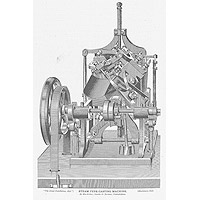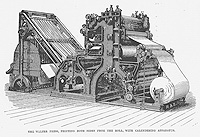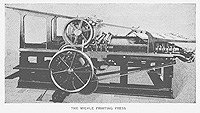Printing-related Machinery
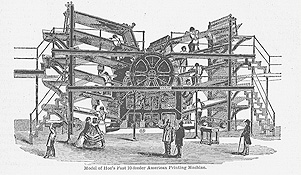 This is an image of Hoe's 10-feeder rotary press exhibited at the second London International Exposition of 1862. Hoe's machine was used by many newspaper publishing companies in the 1860s and 1870s. The development of printing presses, along with that of typecasting machines, composing machines, papermaking technologies, etc., enabled mass printing in a short period of time.
This is an image of Hoe's 10-feeder rotary press exhibited at the second London International Exposition of 1862. Hoe's machine was used by many newspaper publishing companies in the 1860s and 1870s. The development of printing presses, along with that of typecasting machines, composing machines, papermaking technologies, etc., enabled mass printing in a short period of time.
Hand Press - Cylinder Press
Modern printing technologies began with the invention of typographic printing in the middle 15th century by J.H. Gutenberg (see our digital exhibition "Incunabula: The Dawn of Western Printing"). In 1798, C. Stanhope of England developed an all-iron hand press which applied the principle of leverage. The first use of this iron press was at the printing factory of the Times newspaper in London, where it printed 250 sheets, single sided, in one hour.
In the 19th century, against the background of the application of steam engines and the increase in demand for newspapers due to war, highly productive printing presses were developed. Also, in those days, planography (lithography) was devised, enabling easier reproduction of drawings compared to copperplate or wood-block printing, and the development of multicolored printing. Together with the development of photographic and papermaking technologies, which occurred almost concurrently, planography contributed significantly to the growth of modern printing technologies.
In 1812, F. König and A. Bauer of Germany developed a cylinder press (machine to press a plate and paper with a cylinder) operated by a steam engine. Subsequently, upon a request from the Times newspaper, the machine continued to be improved. It had two cylinders enabling simultaneous printing of single sides of two sheets, and achieved a speed of approximately 1,100 sheets per hour.
Typecasting and Composing
In the fields of typecasting and composing, against the background of the development of steam engines, manual labor was replaced by machinery. In 1838, D. Bruce obtained the patent for a hand-operated typecasting machine in the United States. His machine featured a combination of two L-shaped molds into which molten metal was poured with a pump. Unlike previous typecasting, which involved the use of molds and a ladle, his machine enabled much quicker typecasting. Also, along with the improvements in typecasting machines and printing presses, demand rose for the mechanization of composition work, namely the labor of setting types for texts to be printed. While many composing machines were developed from the 1820s by W. Church, C. Kastenbein and others, the epoch-making event was the invention of the linotype, a machine that produced a solid line of type, by O. Mergenthaler of the United States in 1886. Pressing the relevant keys for the text to be printed, just like stroking the keys of a typewriter, selected appropriate matrices, creating a solid line of type in the form of a metal slug. This machine enabled only one person to complete an operation that had once required three persons; thus the machine vastly increased work efficiency.
Development through Rotary Press
With the increase of the circulation of newspapers and other serial publications, the demand for further high-speed printing presses rose. In 1846, R. M. Hoe of the United States put a rotary press into a practical use. He realized continuous printing by fitting wedge-shaped pieces of metal between types, fixing the pieces to a plate cylinder, revolving four impression cylinders around the plate cylinder, and passing paper between the impression cylinders and the plate cylinder. Unlike in the case of an early cylinder machine, there was no need to return a plate to the original position, enabling time reduction. In 1857, upon a request from the Times, he created a huge machine which had 10 impression cylinders and required the paper to be fed by 10 persons. It is said that this machine was able to print 20,000 sheets per hour.
At the London International Exposition of 1851, J. Foster exhibited a newspaper folding machine. The improvement of this kind of machine served as one of the important factors in the subsequent development of high-speed and automatic press printing.
Rotary presses had a defect in that types easily came off from the cylinder. However, the introduction of a method to make a stereotype from a papier-mâché matrix enabled the cylinder itself to serve as a plate. In 1865, W. Bullock created the world's first rotary press to print from a continuous rolled paper web, avoiding the necessity of operators feeding paper manually. The mechanism of his machine was basically the same with that of rotary presses today; a sheet was cut from a paper web, passed between two plate cylinders, during which time both sides were printed, and then delivered to an output tray.
In England, under the direction of J. Walter III, the president of the Times, who was impressed by the model of the rotary press exhibited at the second London International Exposition of 1862, the Walter Rotary Press was developed in 1866. In this machine, a sheet fed from a paper web was humidified, printed on the front side by an upper plate cylinder and on the back side by a lower one, and then the printed sheet was cut and sorted. This machine enabled simultaneous printing of four pages, double-sided, printing 12,000 sheets per hour.
In the 1870s, rotary presses began to be created by the major printing press manufacturers in various countries, such as R. Hoe Co. of the United States, as well as Maschinenfabrik Augusburg Co. Ltd. and König-Bauer Co. of Germany. In France, in 1872, Marinoni, a company that had a deep connection with Japan, developed a web printing press. This machine was different from past ones in that it featured a simple mechanism but nevertheless demonstrated high performance. At the fourth Paris International Exposition of 1889, the company gave a demonstration of high-speed newspaper printing. In 1890, the machine was introduced by the Japanese Naikaku Kanpo Kyoku and was used to print shorthand notes of the first Imperial Diet as a gazette supplement. The machine was also imported by Tokyo Asahi Shinbun.
In 1880, the development of a folding part was activated, aiming for further high-speed performance of the rotary press. Subsequent rotary presses and printing presses achieved high-speed performance as a result of many improvements to the mechanisms of the cutting and paper-feeding parts. In 1893, R. Miehle of the United States invented a two-revolution press, in which an impression cylinder made one rotation to the right and another rotation to the left in a single process, a total of two rotations. Compared to past machines in which an impression cylinder made one rotation in one process, his machine demonstrated drastically increased printing performance. At the Chicago International Exposition of 1893, Miehle's products were exhibited. In 1904, I.W. Rubel invented an offset press (in which image on a plate was imprinted on a rubber blanket and then transferred to paper), which ushered in the age of offset rotary presses.
Printing Press (Hand Press, Rotary Press, etc.) (15 images)
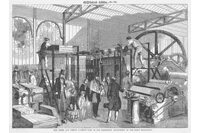 |
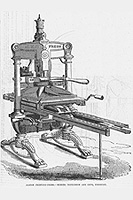 |
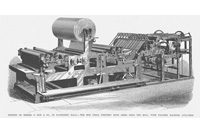 |
| Rotary Press Printing the Illustrated London News | Albion Printing Press Invented by Hopkinson and Cope | Hoe Press' Rotary Press |
Typecasting & Composing Machinery (9 images)
 |
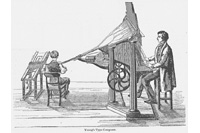 |
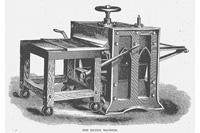 |
| Composing Machine and Type Distributor Invented by W. H. Mitchell | Composing Machine Invented by Young | Campbell's Stereotype Production Machine |
Other Printing-related Machinery (8 images)
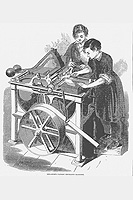 |
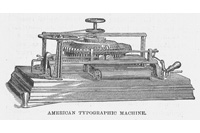 |
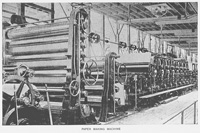 |
| Envelope Machine | Typewriter Exhibited by Dr. A. Shiland | Paper Making Machine |
- References:
'Kindai insatsu no akebono - Sutanhopu to sangyo kakumei' ten zuroku (Toppan insatsu insatu hakubutsukan, 2006) <PE63-H14>
Mawatari, Tsutomu.: Insatsu hatsumei monogatari (Nihon insatsu gijutsu kyokai, 1981) <PE61-E10>
Nihon insatsu gakkai (ed).: Insatsu jiten (Insatsu Choyokai, 2002) <PE2-G6>
Tokyo kikai seisakusho rintenki seizo kaishi 100nen iinkai (ed).: Rintenki no ayumi: Rintenki seizo 100nen kinenshi (Tokyo kikai seisakusho, 2006) <PE63-H13>
Toppan insatsu kabushiki geisha insatsu hakubutsushi hensan iinkai (ed).: Insatsu hakubutsushi (Toppan insatsu, 2001) <PE23-G1>

